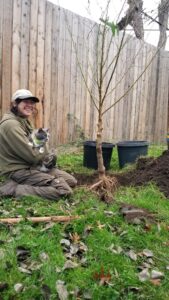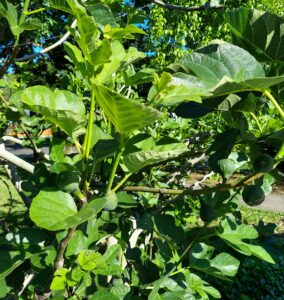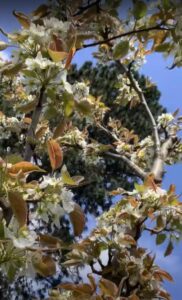Category: fruit trees
Fruit tree recipients in Eugene experience almond joy, and more

NEWS FROM FRIENDS OF TREES EUGENE
FOTE’s yard tree program is growing rapidly, from 35 yard trees planted in the 2019-20 season, to 85 trees in the 2020-21 season—and fruit trees are a big part of Eugene’s yard tree program. We’ve seen a more than 100% increase in fruit trees planted this season over last—40 fruit trees this season vs just about 18 last season. And with some new outreach strategies we’re implementing to reach even more tree recipients, we expect the fruit tree popularity streak to continue.
Almond trees are the top fruit tree choice in the Eugene area (the Hall’s hardy almond tree, to be specific, which is a cross between an almond and a peach tree – !). Hall’s hardy is the only almond variety suitable for growing in the Pacific Northwest because it blooms late, resists fungal disease and self pollinates. Folks love the pretty pink flowers and that they’re fast growing—so fast, in fact that almond trees will produce almonds by the second or third season!
“I love how in just the second year my almond tree flowered profusely and grew so much; I can’t wait to try almonds this fall!”
Laurel, fruit tree recipient
We also offer apple, cherry, peach, pear, Asian pear, and plum trees, and we’re actively looking for a good local source for fig, pawpaw, and persimmon. An important feature of all fruit tree varieties offered by FOTE is that they are pest and disease resistant and don’t require spraying.
When we plant fruit trees in the Eugene area we only plant them as yard trees, and we plant as many bare root trees as possible; they are easy to plant, the roots are good, and they’re a good price for a 5-6 foot tree. We also focus on semi-dwarf varieties that max out at about 20 feet high, these are much easier for the home orchardist to care for than full sized trees (we would love to offer dwarf trees but don’t have a good source yet). Fruit tree recipients are encouraged to have a maintenance plan, because, for instance, most fruit trees need annual pruning.
Why do we expect fruit trees to increase in popularity? We think our new block-by-block outreach approach to let people know about our street and yard trees will simply just introduce fruit trees as an option many folks may not have considered.
Our block by block plan is a new approach to address equity issues within our street and yard tree program. We’re using some mapping software to prioritize neighborhoods that are more diverse, lower canopy, and lower income. Preparation Field Days involve volunteers from the relevant neighborhood association going door to door offering trees. The volunteers will be accompanied either by an FOTE staffer or someone from the City of Eugene, who will mark street tree locations and will also be available for yard tree consultations. So far when we’ve tested this method fruit trees have been very popular; they’ve been offered along with native trees and shade trees.
Would you like a fruit tree of your own? Create a free, no obligation account to get started!
Photo: Eugene Tree Team member Becca and Vera, with their Hall’s hardy almond tree, planted last November
Growing fruit trees is a rewarding hobby

“I love being able to go outside and grab a fresh piece of fruit for a snack – it’s healthy, seasonal, organic, and free.”
-Andrew Land (he/him), Neighborhood Trees Senior Specialist and home orchardist
Home orchardry is a rewarding hobby. Growing and maintaining fruit trees keeps you active, gets you outside, and provides fresh food. Fruit trees are also great trees for small spaces where larger trees just won’t work. Friends of Trees plants about 400 fruit trees every season, and they are an increasingly popular choice for yard trees.
Fruit trees are also a lifestyle—it’s a healthy one, but also one that requires regular, active involvement. As Andrew emphasizes, “Fruit trees are high maintenance. Growing fruit trees is a great lifestyle, but it’s not for everybody.”
Fruit trees require annual pruning, and they are pruned very differently than other trees. They also require extra attention: Home orchardists need to be on the lookout for pests & disease.
Location, location, location! Where fruit trees are planted makes a difference, particularly in terms of sun exposure for species susceptible to fungal disease. For instance, it’s ideal to plant fruit trees that are prone to fungal disease (e.g., European pear, some plum, some apple trees) in a location that gets early morning sun so that overnight dew on leaves has a chance to dry, thus offering some protection from fungal disease.
Friends of Trees works to source pest & disease resistant varieties, and provides all new fruit tree recipients with tree care information specific to fruit trees. However, it’s important to keep in mind that all fruit trees will always require extra monitoring and care (and resistance does not = immunity).
Still interested in growing fresh fruit in your own backyard?
In a typical season our top two recommended fruit trees are fig and persimmon. Why? Essentially they are the most pest & disease-free, they require less water, and they are generally low-maintenance. Another bonus of the persimmon tree is that it provides the last fruit of the year and so lengthens the season of food from your garden. If you’re up for more maintenance we usually also offer apple, plum, and pear trees. All of the fruit trees we offer are on semi-dwarf root stock because it is more drought tolerant than dwarf root stock and the roots of semi-dwarf stock anchor the tree more effectively.
By early fall we’ll know what fruit trees we can offer for the upcoming planting season since fruit tree availability varies largely due what’s available from the local nurseries we work with. On our wish list is the early ripening pawpaw, and if you’ve tried this special fruit you know why: pawpaws (which, fun fact, are the largest fruit native to North America) taste like a cross between mango and banana – !
Unlike most of the trees we plant, the cost of fruit trees is not supported by our municipal partners, who prioritize planting the largest trees possible because larger trees provide greater public health benefits. So beyond the $35 co-pay from tree recipients (which is waived if cost is a barrier to a household getting a tree), Friends of Trees is actually subsidizing fruit trees. Why? There are many benefits to growing fruit trees and, ultimately, we want people to grow trees.
More fruit tree resources are available from our friends at the Portland Fruit Tree Project.
Photo: Fig tree in an urban yard, June 2021 | Video: Jenny’s love letter to her Asian pear tree
Fruit Tree Care

Have you recently planted a fruit tree? Wonder how to care for it? Presenting Fruit Tree Care 101, by Neighborhood Tree Team member and fruit tree expert Andrew Land:
Welcome to the wonderful world of home orchardry! It will not be long before you are enjoying the fruits of your labor in the form of delicious apples, pears, Asian pears, pawpaws, persimmons, and figs (the species FOT plants, but this information can apply to all fruit trees). Not only will you eventually be enjoying a steady supply of fruit, but you are also enjoying all of the economic, environmental, and social benefits that trees provide.
Fruit trees in general have some unique maintenance needs in terms of pruning, harvesting, and pest/disease management. Simply left alone, fruit trees may become more of a burden than an asset. Luckily, there are several great resources in our region to help get you and your new fruit tree(s) off to a strong start.
If you don’t already know the fundamentals of how to be an orchardist, the Home Orchard Society is a great resource for fruit tree care through its website and workshops. Additionally, the Oregon State University Cooperative Extension allows you to “ask an expert” your fruit tree questions, and if you’re north of the Columbia River the WSU Extension website has some great resources on a variety of fruit-related topics. Finally, Portland Fruit Tree Project is also a fantastic resource.
Your fruit tree will need annual pruning to ensure a regular crop and unlike a shade tree, fruit trees should be pruned the first few years they’re in the ground to establish strong architecture before the onset of fruit. We’ve distilled some of the basics of pruning into a concise basics of fruit tree pruning flier that you can print and take with you out to the garden. If you’re inspired to go more in depth or have additional questions, here’s a more in-depth fruit tree pruning basics video from an OSU Master Gardener & Clackamas College.
Beyond that, keep in mind that on your new fruit tree you should be able to make all of your cuts with bypass-style hand pruners (at left in this image) that have two blades as scissors do. Please note that anvil-type pruners are not intended to be used on live wood.
Properly planting and caring for a fruit tree is a commitment, but one that is definitely worth the effort. Questions? Feel free to email me and I’ll do what I can to help.
Pictured above: Asian pear tree in glorious bloom.
